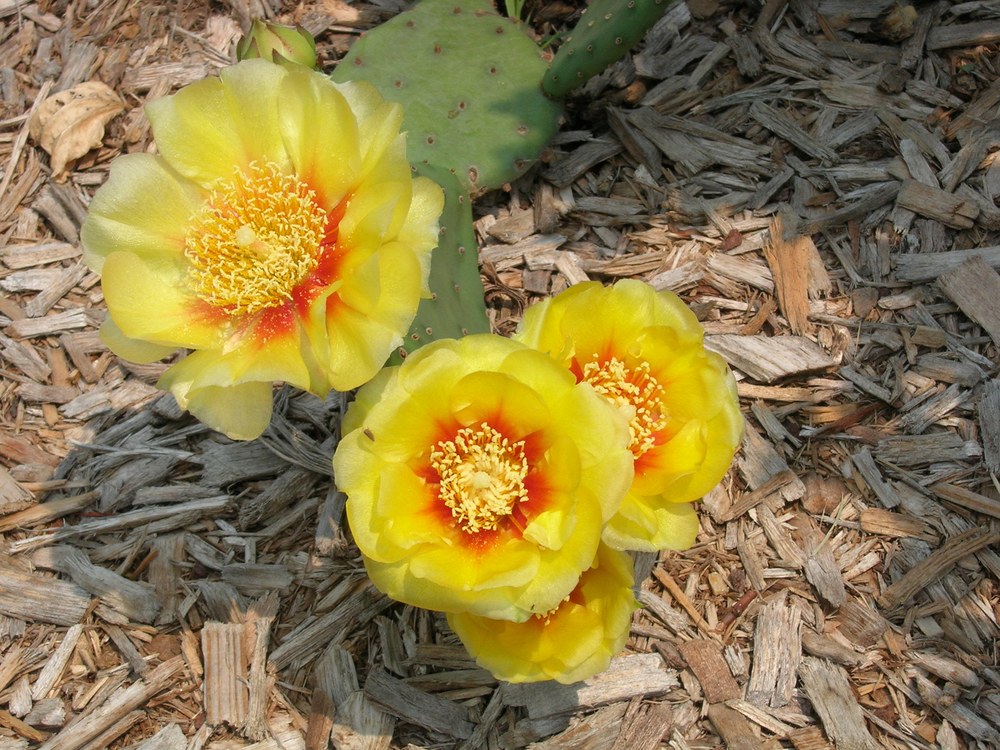Posted: February 21, 2025
If I asked you where to find cactus in the United States, you would undoubtedly say Arizona, New Mexico, or the southwestern part of the country. And you would be correct. But is there a cactus closer to home? And how would you take care of it?

A form of Opuntia humifusa called caespitosa in bloom
You may be surprised to know that there is indeed a prickly-pear cactus that is native to many of the states east of the Rockies. This includes Pennsylvania, where it is limited to the southern border counties from Bedford to Lancaster and in Montgomery, Monroe, and Pike. It prefers dry, shale soil.
Due to the usual reasons, notably development and habitat loss, this cactus is rare in the wild today. In fact, that is its designation on the Pennsylvania list of rare and endangered species and plants. We'll come back to this and its importance for our plant and others in a bit.
Eastern prickly pear (Opuntia humifusa) is a shrub-like cactus that starts out as a low-growing plant that can get a foot or more tall. It fits the image most of us have about cactus: pale green pads spotted with whitish round aureoles but without spines. However, the fuzzy aureoles contain an abundance of glochids. These are small, almost microscopic, harpoon-like hairs. They are barbed and very sharply pointed. If they get on the skin, they will work their way in and become very painful. Because of their fine texture, it is difficult to remove them.
Like most cacti, this plant likes sunny, dry, rocky soil. Planted in a garden with full sun and good drainage, the plant will grow readily and produce numerous yellow flowers. It will also spread out as it settles in.
As with many plants in the cactus world, as noted on the Master Gardeners of Southern Virginia website, authorities place about eight species, all closely related, in the Opuntia humifusa category. This same website names two other species that are very similar and, until recently, were considered variants: Opuntia mesacantha with a pale-yellow bloom, and Opuntia caespitosa also with a yellow bloom that has a red center. Both of these plants bear spines up to an inch long on the glochid-covered pads.
The blooms will appear around the margins of the pads. As the bloom fades, it is replaced by dark red fruits called tunas. These are the seed pods. They are edible, as are the pads. I do not recommend eating them unless you have been taught how to harvest and prepare the pads to remove all the glochids and make them safe to cook and eat.
The cactus is easily propagated. Carefully remove a pad, let the end callus over, and plant it in a dry, sunny area. You may also find that a fallen pad or seed pod has already put down roots. It can be easily moved to a new area of the garden or potted on.
When the weather turns colder, and winter sets in, the cactus turn yellowish or brown and appear to have been deflated, the now-wilted pads lying on the ground. When winter is over and warmer weather returns, the plant will gradually fill with water and stand upright and perky. Soon, it will flower and provide a colorful, bright spot in your garden.
In Pennsylvania, the cactus is classed as 'rare.' This means that if you are fortunate to find it in the wild, do not dig it up or take any part of the plant. Leave it to grow on its own. Worldwide, cactus and succulents are under assault from poachers who remove them from their habitat and sell them on the black market. Make sure to purchase your plant from a reputable nursery or garden center that provides only seed-grown cacti. Do not be reluctant to ask about the provenance of the plants they stock. Beware of online sources that may provide questionable plants or cannot, or do not, provide the source of the plants they sell. Trust nurseries that state that their plants are seed-grown.
Once you have your cactus, select a sunny location with good drainage and get ready to plant it. Wear heavy leather gloves and good eye protection. Handle the plant with respect and care. Those glochids are not fun to remove. And, yes, even leather gloves can be penetrated occasionally. Be careful.
Plant the cactus in the ground. A rock garden or dry slope suggests itself. The cactus also likes potting. As a pot plant, it can be moved to a location of your choice and protected for winter. When potting, choose a pot that drains well and fill it with good cactus soil. Do not fill the bottom with pebbles. This can retain moisture near the plant's roots and can cause root rot and kill the plant.
Cacti do have a 'front,' that is, a side from which they appear more attractive. Turn the plant until you find it and present that view. Whether as a container plant or in a rock garden any of these cactus species will provide years of interest and colorful blooms in your garden.
Phil Peters is a Penn State Master Gardener from Adams County. Penn State Cooperative Extension of Adams County is located at 670 Old Harrisburg Road, Suite 204, Gettysburg, 717-334-6271.
Master Gardener Hotline is open Wednesdays, from 10am to 2pm. Please send an email (with pictures, if possible) to adamsmg@psu.edu with your gardening questions or stop by Penn State Extension, 670 Old Harrisburg Rd, Gettysburg.

